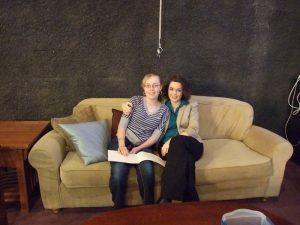This is an article I wrote for Autism Speaks – I wanted to put it here in case it’s helpful to anyone here as well.
Sensory Processing Disorder (formerly called Sensory Integration Dysfunction) is closely aligned with autism in that most autistic children have significant struggles with SPD. The following is an editorial from Jennifer Shaw whose son was diagnosed with SPD. Jennifer is a speaker, singer, songwriter, and author of the book Life Not Typical: How Special Needs Parenting Changed My Faith and My Song, an Autism Speaks resource. Visit her online at www.jennifershaw.com
I was the mother of two beautiful girls and was thrilled to add a son to our family. When Toby was born after a difficult and dangerous pregnancy we were especially thankful that he was healthy. He seemed to be a very unhappy baby compared to our girls, but we hoped he would grow out of it.
The first indication that something was out of the ordinary was when we could not get him to eat any food. I had nursed him without any problems, but when we introduced baby foods, it was a daily struggle that we lost. We also noticed that he never babbled or made any sounds and he rarely smiled. Eventually it was clear that he was very speech-delayed, but because he had suffered from repeat ear infections which caused clinical deafness during his first year, we attributed a lot of his irritability to pain and hoped that when his hearing improved, his speech would come along. After surgery on his ears, his hearing did get better and the infections went away, but he still did not make any sounds.
During Toby’s second year, my father was dying of ALS and that took much of our emotional energy so we did not react as quickly to the signs we were seeing in Toby as we might have otherwise. Still, Toby’s behavior was getting more and more extreme. He wouldn’t touch anything or play. He did not want to be touched. He was terrified of being messy or being anywhere near things like grass or sand. A drop of water on his clothing would make him scream. It became really frightening and we did not know how to help him.
When Toby turned two, we started him at a therapy school for speech delay. There was an occupational therapist on staff and she was the first to diagnose him with Sensory Processing Disorder (previously known as Sensory Integration Dysfunction). Toby’s brain was not interpreting sensory input correctly. People with this disorder can suffer in a variety of ways, but in Toby’s case, he was extremely hyper-sensitive to touch of any kind. Food in his mouth, clothes on his skin, crumbs on his hands were all completely intolerable to him –his brain told him they were “hurting” him. He was completely terrified of his world and shutting down.
Toby began play-based occupational therapy, speech therapy, some physical therapy (because he didn’t touch things or play and had poor balance his muscles were very weak), and food therapy. Within two months my son who had no sounds said, “I love you, mom,” and within a year, Toby’s progress was nothing short of miraculous. He is now eight, and has been discharged from all his therapies for the past three years. It is absolutely amazing to see the change in him and such a blessing to see him able to enjoy his world.
I am a speaker and musician, not a doctor or therapist, but we learned a lot of things along the way that I share with people who suspect this condition in their own children. There is so much hope if you know where to look, and although Toby’s outcome is not typical, there is help for every child with this diagnosis. So here’s my advice:
Do not ignore the signs, even if you don’t know what they mean. This is by no means a comprehensive list, but some of the symptoms of SPD are speech delay, poor coordination, poor balance, avoiding touch or seeking touch in extreme ways (running into walls or falling down on purpose, running into people), extremely picky eating or extremely messy eating, irritability or a “difficult” personality. SPD is often misdiagnosed, especially in older children or less severe cases, as ADD or ADHD.
Do not wait, even when your pediatrician tells you to. After everything we went through with Toby, my pediatrician (whom I love and really respect) told me that she gave me the wrong advice by advising me to wait for Toby to catch up. This may be good advice for many problems, but SPD is not one of them. Early intervention is critical, and treatment is so much more effective before the age of three that you cannot afford to waste time. If you suspect something, get tested by an occupational therapist – if they say there’s nothing to worry about, fine, but if not, you have not wasted valuable time for therapy.
Get help. There is a federal program for ages 0-3 “developmentally-different” children available in every state. It goes by many different names – ours was “Help Me Grow”. They will do testing and help get your child into therapy programs, many of which are free if you qualify. Toby’s therapy program literally changed his life and ours. You can call the special needs department at your local school district and they are usually able to tell you who operates the program in your area. If your child is over the age of three, help is available through your local school district’s special needs department. Take advantage of any therapy coverage on your insurance plan.
Get educated. Find out all you can, and do everything you can to help at home. An excellent book on SPD is The Out of Sync Child by Carol Stock Kranowitz. Talk to your therapists about what you can do at home, watch the therapy whenever possibly, and ask a lot of questions. We continued all of Toby’s therapies at home, and really attribute a lot of his gains to this. We were able to overcome a lot of Toby’s food issues only because we worked on it every day at every meal and because we had learned techniques from our therapists.
Re-define baby steps. This is not a quick fix. For example, Toby was literally afraid of food. We were not usually able to get him to stay in the same room with us while we ate – sitting down and eating a meal was out of the question. So first, we worked on getting him to be with us in the room at meals, then getting him to sit at the table, then allowing us to put food on the plate, then touching the food with a fork, then touching it to his tongue but not eating it, etc. It was a long, frustrating process, but my son eats a healthy diet now and enjoys mealtimes with our family. The simplicity of a family meal has become a true blessing in our lives.
Get support. Dealing with special needs can be very lonely and frightening. Our church and our faith were amazing supports to us and truly what held us together at times. The other parents of special needs children at Toby’s school were also a wonderful source of support. Realizing we were all dealing with similar challenges and emotions helped us see that we weren’t alone. They were also a wonderful resource for practical ideas as we all talked about what was working or not working for our children.
Don’t give up. SPD can be overwhelming and confusing. It can be hard to navigate the therapy system. Every therapy will not work for every child and you will need to be careful and wise about your choices. Take comfort in knowing that there is help and things can improve. You are your child’s best advocate, and your child needs you.

























